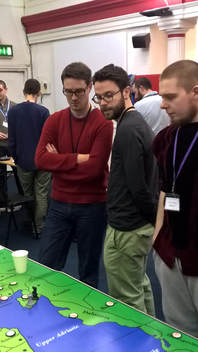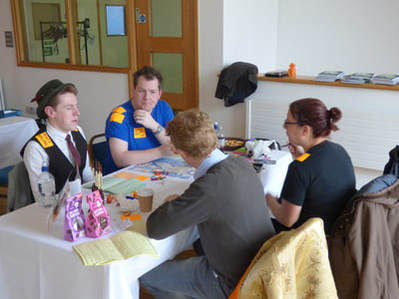Story Living Games as part of training and developing your workforce

People are generally familiar with games for recreation, as a way of passing time. “We’re much happier enlivening time than killing time.” In many traditional hobby games, winning is often the focus, but the interaction between players are increasingly a focus and in recent years there has been a rise in the number of cooperative games entering the market.
The military have used wargames and simulations for many years and more recently business wargaming has grown in popularity. From a hobby perspective, there has been an increase in boardgaming (often because of the social aspect), as well as large multi-player ‘megagames’ and a growth in problem-solving ‘escape rooms’
Story Living Games aim to take elements from all these, to provide players with an immersive experience, that both reveals and develops skills, whilst also providing an environment in which ‘fun failure’ can lead to greater creativity and perseverance, leading to a sense of accomplishment, whilst also sometimes recognising the need for compromise.
'I loved the confusion, interaction and the mischievous umpires'
The military have used wargames and simulations for many years and more recently business wargaming has grown in popularity. From a hobby perspective, there has been an increase in boardgaming (often because of the social aspect), as well as large multi-player ‘megagames’ and a growth in problem-solving ‘escape rooms’
Story Living Games aim to take elements from all these, to provide players with an immersive experience, that both reveals and develops skills, whilst also providing an environment in which ‘fun failure’ can lead to greater creativity and perseverance, leading to a sense of accomplishment, whilst also sometimes recognising the need for compromise.
'I loved the confusion, interaction and the mischievous umpires'
|
Benefits
For players: the opportunity to develop decision-making, planning, problem-solving and negotiation skills, lateral-thinking, empathy and a deepened understanding of a situation. An appreciation for the ability of colleagues and deal with time and resource pressures. For organisations: The games are easily adaptable and can be tailored to suit clients’ specific needs. Their nature, which focuses on interaction between and within teams often reveals a great deal about participants, due to their unguarded nature whilst engaged in the ‘flow’ of the game. Whilst activities are designed to encourage fun learning, skills are transferable to the workplace. 'Well-paced, the game mechanics were easy to understand' |
Format
The games are usually run for between 20 and 60 players, who are organised into smaller teams, usually with some competing and complementary objectives. Sometimes the setting might be a familiar one, but existing hierarchies are not encouraged, as this can inhibit creativity. Example scenarios include:
Why Story Living Games? Paul is an experienced educator and trainer, who has used these activities in schools to enthuse young people, whilst working with other professionals who also recognise the wider application of their principles. |

